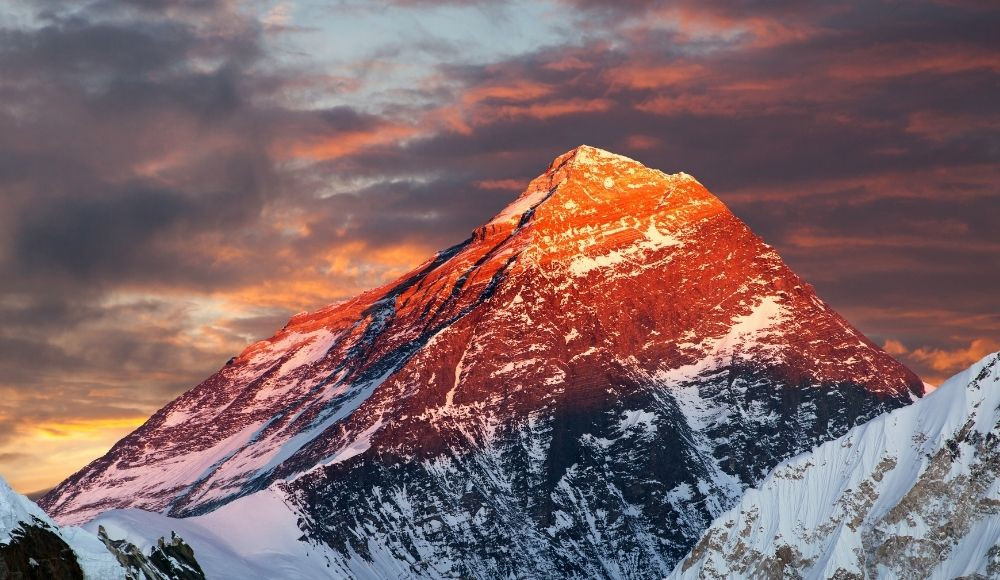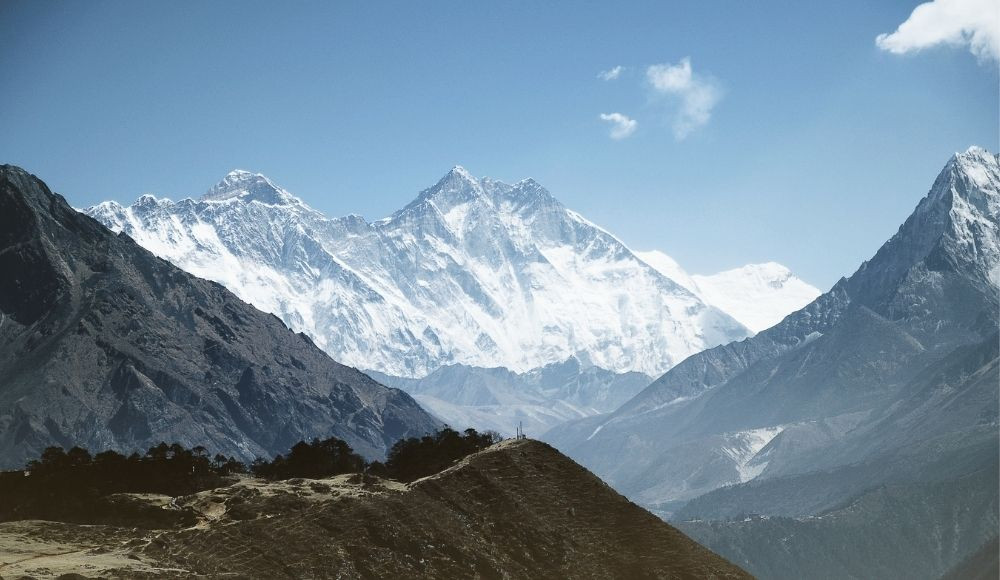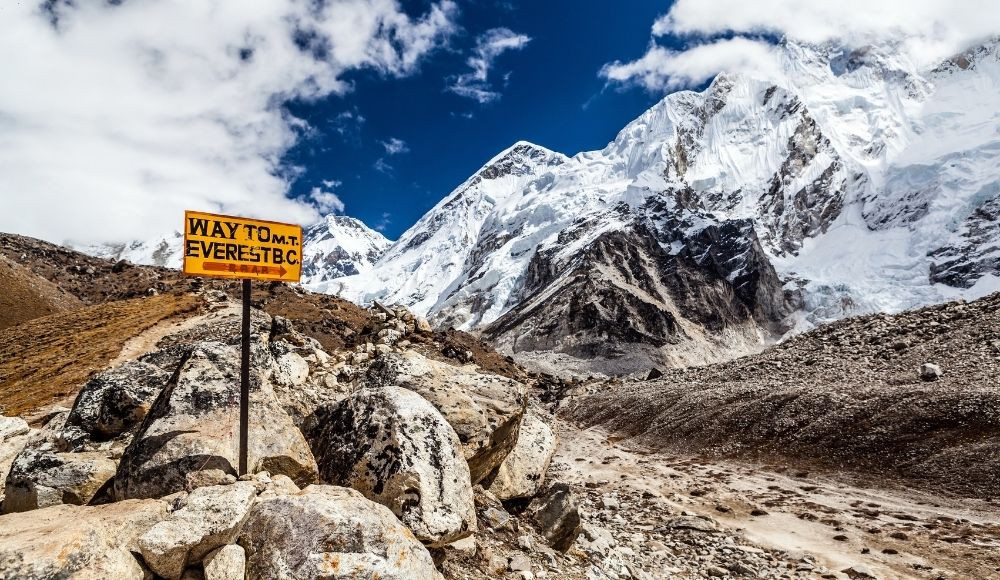Everest Base Camp Trek
Trip Facts
Trip Highlights
- Scenic flight to Lukla, and the exploration of the Lukla market.
- Strolling around the Gateway of the Himalaya, Namche Bazaar.
- A subtle touch to the lifestyles of the Himalayan Heroes, Sherpa ethnic groups and their settlements.
- Passing through the various Suspension bridges; a nightmare to the acrophobic and trek alongside the great, roaring Imja and Dudh Koshi rivers.
- Multicoloured oscillating prayer flags, chortens, monasteries, mani walls and several others holding firm religious beliefs.
- Breathtaking views of the gigantic Everest, Amadablam, Pumori, Lhotse, Cho Oyu and many more peaks.
Route Map
Trip Overview
Getting up to the pinnacle of the world’s roof might be the fantasy of many but not everyone can try it. So, to be closer to their wildest dreams, they go for the near vicinity of the mighty Everest. And this Everest base camp trek is all about it. It is a 14-day Everest tour in which you will roam around the charisma, glam, and glory of the Khumbu region. The Everest base camp trek is the most popular trek in the context of the naturally blessed and graced Nepal. When the word popular arrives, everyone gets that specific eagerness. Why so? It's because it is unique on its own. From the culture to the geography this trek has adequate diversity and this is what's responsible for its enormous appreciation and praise all over.
This trek to Everest base camp starts with the scenic flight to Lukla which is considered one of the scariest flights in the world. This arrival at the Lukla airport marks the beginning of your amazing journey in the Everest region which elevates up to the Kalapathar(5545 m), known as the highest point of this trek. There are various packages and trips designated for the Everest base camp trek. You can find plenty of them in various trekking companies but not everyone thinks of your comforts and physical endurance. So, concerning all the relatable circumstances with possible hindrances and your availability through convenience, we at Altitude Himalaya have arranged a 14-day itinerary for the infamous Everest base camp trek.
As you are trekking to the Everest base camp, you may have already inquired about the height of Everest, the best treks in the Everest region, and life, possibilities, and tourism in this region and likewise. So, I am not going up there as it is the very basics, but before joining any trek, you need to especially take care of the timing as timing determines the trek. Whether it will make it or break it. So, the most ideal time for the Everest base camp trek would be the Autumn and Spring seasons. In the Autumn season (September, October, November) the atmosphere will get clear providing outstanding visibility while in the spring (March, April, May) the weather will be good, neither too hot nor too cold making it the perfect time for the trekking. So, you can join this amazing Everest base camp trek during these periods. Additionally, before plunging on the Everest base camp trek, you need to look after your travel health insurance. Your present health insurance may not cover international travel and tour. As you are getting to an elevation above 5000m, there is a high risk of getting high altitude sickness during this trip. So, get nice health insurance prior, covering the helicopter services in case of an emergency too. This is something you must do before joining the trek.
In this 14 days Everest base camp trek, you will cover a total distance of 130 km from Lukla back to Lukla through varied topography and the plains. Here, You will pass through several rivers, streams, suspension bridges, woodlands, glacial valleys, high passes, and small mountainous settlements. Often asked by foreigners, where is Everest base camp? This Everest base camp trek has gotten the hype and needs not any advertisement amidst the mass. It is one exclusive feature of the Everest region scattered over the eastern territory of Nepal in the district of Solukhumbu. It is settled within the Sagarmatha national park which is also a national park inscribed in the world heritage site. So, not only the mountains but you can also peek into the flora and fauna abundant in this national park during this trek.
Talking about the flora and fauna, this national park is the habitat of the elusive Himalayan predator, the Snow leopard. Though it is very unlikely to encounter this wild beast, some lucky fellows may encounter this too. Apart from this, it also shelters many faunas such as Himalayan mouse Hare, Pikka, Himalayan Tahr, musk Deer, Snow cock, Bearded Vulture, and so on. The occasional appearance of the wild ones during the trek creates a diversion from the monotonous trek. Everest being the center of attraction steals all the thunder of the trek. But this does not mean it is the only attraction this trek has got, it is obviously the major one but not the only one. There are many others such as the Himalayan hub Namche Bazar, one of the world's most dangerous airports, Lukla airport, the culture and customs of the locals, outstanding views from Kalapathar, Everest base camp, and perfectly balanced mountainous biodiversity.
Namche Bazaar and the spiritually healing monasteries
Namche Bazar is the administrative center shaped like a horseshoe. It is the Sherpa capital from where you could get the first glance of Everest. It has got facilities such as pubs, cafes, ATMs, health posts, and plenty of shops with trekking gear and essentials. You can get into the hustle and bustle of this mountainous city, which is quite amusing. Coming to Lukla airport, the experience you will receive during the landing and taking off of the plane is a pure thrill, yet the excitement kicks in and the thrill gets replaced with amusement easily. The multiple monasteries on the trails to the base camp demonstrate the religious values of the locals. Note that the vistas of the monastery are not the actual gain, it is just a mere amusement to your eyes but the actual gain is in the positivity it radiates. You will get a piece of mind and relief on these religious grounds. Many trekkers spend time in these sacred lands during their trek as they seek mental peace. A perfect balance between the mind and the body is the key to sound health. And this trek can grant you this, hence admired by many.
Everest Base Camp, Kala Patthar, and diversion to Ramechhap
Though the trek is titled the Everest base camp, Kalapathar becomes the heart and takes the limelight. From here you could get a panoramic view of the tallest mountains above 8000m including the majesty of Everest. Especially the sunrise and sunset behind the grandeur of Everest look totally spectacular from Kala Patthar and this justifies your every ounce of struggle during the trek. Many trekkers think that as the name suggests Everest base camp, they could catch the wonderful sight of Everest from here. But you can't see Everest from the Everest base camp. So expecting a catch of Everest from the Everest base camp may highly disappoint you. What actually you can expect from this Everest base camp trip is the mighty appearance of Everest from Kalapathar, beautifully nestled mountainous hamlets, and the distinct flora and fauna of the highest elevated national park. Complementing it are several Himalayan giants such as Amadablam, Thamserku, Pumori, Changtse, Lhotse, Lobuche, and many other 7 and 6 thousanders.
Apart from the peaks and the Himalayan giants, You could explore the Himalayan settlements, their lifestyles, customs, practices, dialects, ornaments, and their warm hospitality during the trek. Also, in the lower elevation of the trek, you will pass through various woodlands and alpine meadows, which the visitors name enchanting forests. The trails through the colorful rhododendrons and the aromatic junipers, and the birches with the hanging lichens on the tree branches highlight the trek luring large no of visitors.
As we have discussed all the attractions, whereabouts, and expectations from the trek, this all information would be worthless until you know how to get here right? So, let's just dive into it. Don't make it a big hush, Getting to this wonderland is as easy as pie. You just have to take a flight to Lukla or just get a bus to Jiri. Then you have to trek onwards as there are no motor roads above here. Coming to the flight to Lukla, slight changes have been made regarding this flight since last year. Because of the heavy traffic congestion in the peak season, a diversion to the Ramechhap is made from Kathmandu to manage the air traffic in Lukla airport. So, don't worry too much in case your flight gets diverted to the Ramechhap airport.
Everest Trek Permits and Backpack Essentials
Landing your foot on the Lukla welcomes you to the long journey ahead to the base camp. But before you jump into it, you need to have all the Everest base camp trek permits. For this, you need to have two permits; Sagarmatha national park permit and the Khumbu Pasang Lhamu rural municipality permit. You can get the Sagarmatha national park permit from DNPWC, Kathmandu, Lukla, and Namche and for the Khumbu Pasang Lhamu rural municipality permit, you need to visit the Khumbu municipality itself. Thinking of trekking and planning the trekking are two different things. So, before you make up your mind about trekking in the Everest region, you need to pay good attention to the trekking backpack essentials and gear. Generally, for this trek, you need to pack some warm clothes, a map, a first aid kit, water bottles, and some medicines. Just keep a note of packing your backpack as lightly as possible as trekking through the complex trails with a heavy backpack might be a wild nightmare. Lastly, one question will arise in your head regarding this trek which is how difficult is the Everest base camp trek? It is not as easy as pie, but not that impossible either. So, don’t panic and plan the trek accordingly.
Related trip: Mount Everest flight from Kathmandu
Detailed Itinerary
Kathmandu Arrival.
Fly to Lukla, Trek to Phakding.
Trek to Namche Bazaar.
Acclimatization in Namche Bazaar.
Trek to Deboche.
Trek to Dingboche.
Acclimatization in Dingboche.
Trek to Lobuche.
Trek to Everest Base Camp, back to Gorek Shep.
Trek to Kala Patthar, descend to Pangboche.
Trek to Namche Bazaar.
Trek to Lukla
Fly back to Kathmandu.
Departure.
Trip Guide
The given information about Everest Base Camp Trek is in-depth, feel free to contact us 24/7 for any kind of assistance. We will be available on WhatsApp to assist you instantly. You can write an email if this trip doesn't fit with your vacation schedule and requirements. Altitude Himalaya aims to offer the best possible travel experience to the customers. Depending on the needs of the visitors and the group size, we customize each vacation package. We will put together a bespoke itinerary just for your private group.
Frequently Asked Questions
-
Where is the Everest base camp trek?
Everest base camp trek is in the eastern region of Nepal, a territory of province no 1 in the district of Solukhumbu commonly called the Khumbu region. It lies within the Sagarmatha national park and boasts several flora and fauna.
-
How hard is the Everest base camp trek?
The Everest base camp trek is listed as one strenuous trek overall. Since the highest point of this trek is the Kala Patthar (5545m), there is a high chance of getting altitude sickness here. Besides this, the trails are not that easy either, making it difficult to trek.
-
Can a beginner join the Everest base camp trek?
It would be better not to join. You need to practise trekking at a higher altitude beforehand for the Everest base camp trek. Sometimes, this trek may be life-threatening too, so think once again if you are a complete beginner.
-
Why is the Everest base camp trek popular?
The major accumulator is the world's highest peak, Mount Everest. Complementing it are the dramatic landscapes, flora and fauna, and culture, traditions and practices of locals. So, it can be concluded that the blend of nature, history, culture and heritage is the reason behind the popularity of the Everest base camp trek.
-
What are the major attractions of the Everest Base Camp Trek?
The diverse landscapes, rivers, streams, waterfalls, flora, fauna, an array of peaks which indisputably includes Everest, and small mountainous settlements are the major attractions of this Everest base camp trek. Aiding it are the culture and traditions of the locals.
-
What is the best time to join the Everest base camp trek?
September, October, November, and March, April, and May are the perfect time for the Everest base camp trek. From September to November, the weather is nice with better visibility and from March to May, the temperature is good with bright sunny days making it an ideal period for the base camp trek.
-
Is there any age limit for trying out the Everest base camp trek?
No, there is no age limit for the Everest base camp trek. If you are willing to, you can join this trek but in order to accomplish this trek, you need to be physically fit with a past experience of trekking in some other regions.
-
What are the permits required for the Everest base camp trek?
Two permits are required for the Everest base camp trek. One of which is the Sagarmatha national park permit and the other is Khumbu Pasang Lhamu rural municipality entrance permit. You can get the national park permit from DNPWC, Kathmandu and many other regions, but for Khumbu Pasang Lhamu rural municipality entrance permit you need to visit the Khumbu municipality itself.
-
What is the maximum elevation of the Everest base camp trek?
Kala Patthar being the highest point houses the maximum elevation of this trek which is 5545 m. From here you could get a 360-degree view of the peaks including Everest and also Everest seems much closer from here making it the ideal spot for the trekkers craving a closer approx to Everest.
-
What is the possibility of getting altitude sickness during this trek?
There is a high chance of getting altitude sickness on this trek. Since it's pretty common to get altitude sickness above the elevation of 3000m and the highest point of this trek is 5645m, many trekkers face altitude sickness on this trek starting from Dingboche.
Services Includes
-
Kathmandu arrival airport picks up and drops off.
-
Flight transportation from Kathmandu/Lukla/-Lukla/Kathmandu or from Ramechhap to Lukla and Lukla to Ramechhap.
-
Land transportation from Kathmandu to Ramechhap and Ramechhap to Kathmandu if Lukla flight operated from Ramechhap.
-
Two nights hotel (3-star) accommodation in Kathmandu.
-
Daily breakfast throughout the trek.
-
Lodge or teahouse accommodation during the trek.
-
Lunch and Dinner from the trek start day to the trek end day. ( as mentioned)
-
All necessary paperwork. (required permits)
-
An experienced and licensed English-speaking trekking guide throughout your trek.
-
Guide and porter’s food, salary, accommodation and allowance.
-
All government and local taxes.
-
One local sim card during your stay.
-
Arrangement of an emergency helicopter service which will be covered by the traveller's insurance.
-
Traditional Nepali cultural dinner in Kathmandu on your farewell.
-
Sleeping bags, Duffle bags to carry goods and trekking maps - if necessary
-
A porter during the trek. (a porter can carry up to 20/22 KG of baggies)
Services Excludes
-
Personal expenses.
-
Lunch and Dinner in Kathmandu.
-
Kathmandu sightseeing entrance fees.
-
Nepal visa cost (you will require two passport-size photos and 30 USD)
-
Travel health insurance. (highly recommended)
-
Tips for the guide, porter and anyone.
-
International flights.
-
Sweet things like dessert/chocolates during the trek.
-
Any alcoholic and non-alcoholic drinks.
-
Hot showers/batteries charge/heater/ mineral water during the trek.
-
Any other expenses which are not mentioned in the including section.
Videos
Why Travel With Altitude Himalaya?
We believe in the quality services to accommodate our guests 360 degrees need with tour personalization and customization. Our dedicated and experienced team believes not only in arranging trips, but making creating life long memories. Our travel experience within the region of Nepal, Bhutan and Tibet could make a memorable trip of yours.
Confirm Your reservation Now


TALK TO AN EXPERT
we can help you find your perfect holiday
Mr. Kiran has experience of 10+ years in tourism across Nepal, Bhutan and Tibet holiday arrangements to thousands of travellers from around the world. He will help you to figure out the best possible vacation plan according to your choice and preference.







 Duration
14 days
Duration
14 days
 Trip Difficulty
Difficult
Trip Difficulty
Difficult
 Highest Point
5545 m.
Highest Point
5545 m.
 Average Group Size
2-10
Average Group Size
2-10
 Trip Code
EBCTAH
Trip Code
EBCTAH
 Area
Everest Region
Area
Everest Region
 Start Point
Kathmandu
Start Point
Kathmandu
 Trip End Point
Kathmandu
Trip End Point
Kathmandu
 Accomodation
Lodges
Accomodation
Lodges
 Meals
As Mentioned
Meals
As Mentioned
 Transportation
On Private Basis
Transportation
On Private Basis
 10 Km
10 Km
 1350m
1350m
 3930m
3930m
 Send an email
Send an email +9779823000055
+9779823000055 +9779823000055
+9779823000055